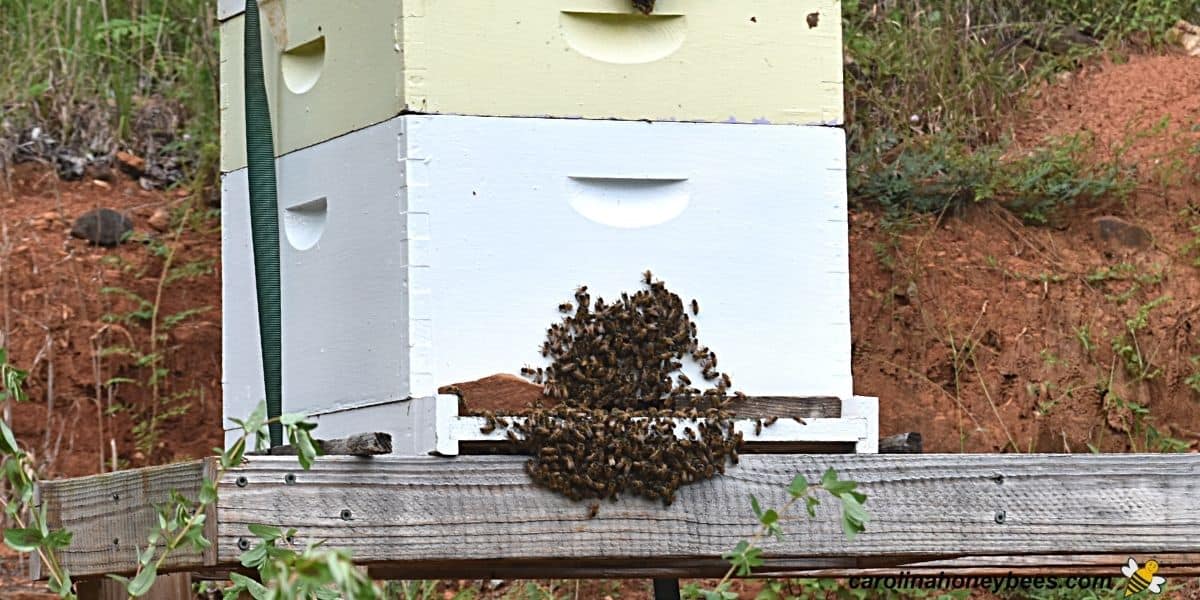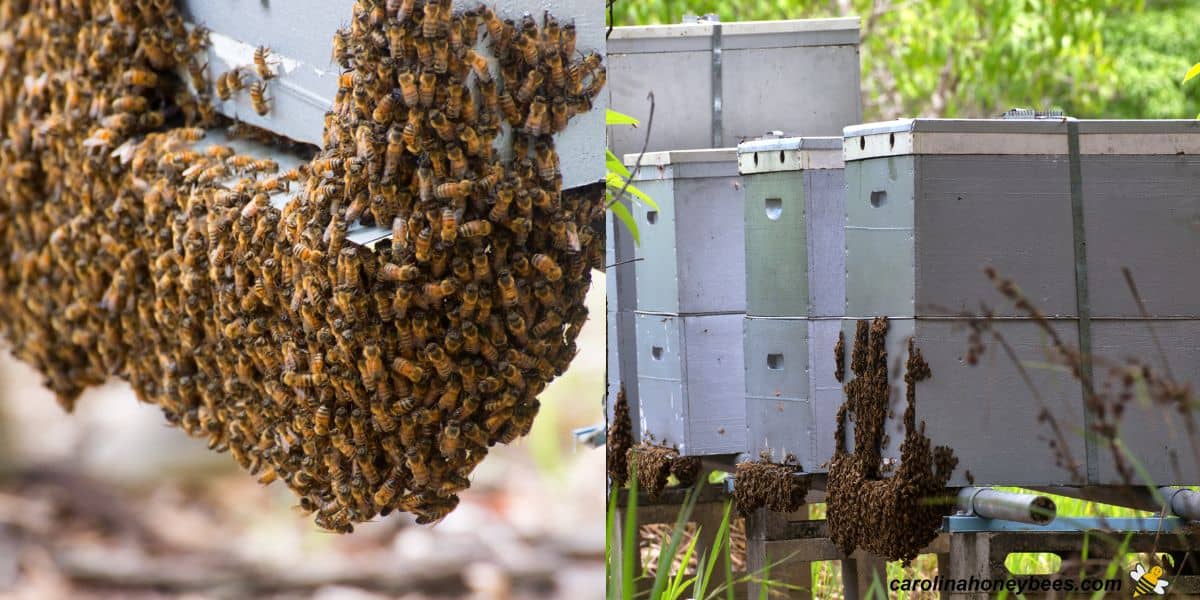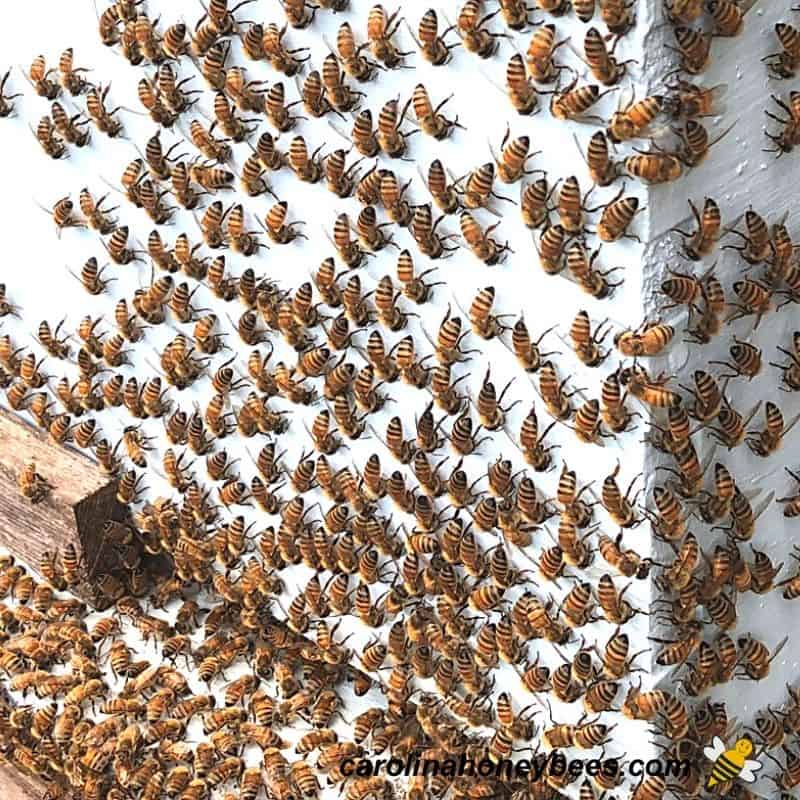Bee Bearding
A common activity here in the hot, humid Southeast is Summer bee bearding. Near the front entrance of your hive, a fuzzy mass of bees just seems to hang from the bottom board. It can be rather alarming to new beekeepers. But in most cases, there is no cause for alarm. As with most things related to honey bees, they are trying to tell you something

As hundreds of bees hang onto the landing board and each other, you may wonder if there are any left inside. One of the most interesting parts of good beehive management is trying to understand the reason for a certain bee activity.
Should You Worry About Bees Bearding on the Hive?
In most cases, seeing bees bearding on the front of the hive is not cause for alarm. Your colony is only reacting to weather conditions.
They hang in a clump from the hive entrance – for the same reason that we like to sit on the front porch and enjoy a cool breeze.
It gets hot inside a beehive. Thousands of individuals add more body heat and restrict the flow of cooling air.
Good ventilation is important during all the year. Worker bees strive to keep bee brood in a proper temperature range. If internal hive temperatures become too great, the young will die.
Bees in the beard are calm and still as they congregate near the hive entrance. Some of them may be fanning their wings to push cooler air into the hive.
They look so intriguing that you may want to touch them – don’t! We know why honey bees sting -for defense and they will feel threatened.

When It is Most Common
The most common times for bee bearding to occur is during hot weather or warm very damp weather. Of course, strong colonies with a large population are most likely to beard than a weak hive.
Sultry Summer Evenings
Hot Summer evenings are the most common time to see bearding bees. The students in my online beekeeping class – often ask how to get their bees to go inside.
When the night cools off, the honey bees will usually return to the inside of the hive. In times of extreme heat, humidity and crowding, some bearding on the beehive may still be obvious the next morning.
Warm Rainy Weather
It is not uncommon to see a strong colony bearding on a rainy day – even if the temperatures are not high. Again, this is an attempt to control heat and humidity inside the hive.
Also, because not all bees fly in bad weather-all of the workers are at home with nothing to do. Normally, honey bees don’t fly in the rain most stay home. Rather than be in the way inside – they may choose to move outside.

Bearding Bees vs Swarming
When a beekeeper first experiences bearding, it is common to think the hive is about to swarm. This is not so.
Honey bees in a beard do eventually go back in the hive as the temperatures cool. While a swarm of bees will simply leave the hive.
When honey bees swarm they do not hang on the front of the hive in motionless clumps. Instead they leave the hive and hang nearby until ready to leave for their new home.
However, you must remember that a colony with a large population may experience more crowding and have a larger beard. Likewise, a large colony is always more prone to swarming.

Bee Bearding vs Washboarding
Another unusual activity – that is different than regular bee bearding – a spread of bees seeming to wash the front of the hive. Instead hanging in a clump, many are spread around the front of the hive moving rhythmically.
This is called Washboarding bees. It happens more in times when incoming food is sparse. As late afternoon arrives and foragers can not find a lot of food in the field – they stay close to home.
What You Should do If Your Hives Beard?
- don’t try to make the bees go in
- check hive for crowding
- watch for swarm cells
When you notice bees bearding on one of your colonies, do not try to interfere. They will most likely go back in the hive as the temperatures cool.
Trying to make the bees go inside with bee smoker or other methods is just a useless waste of time and stressful for the colony.
If you have only one hive that is bearding every day and other hives are not, you might want to perform an inspection of the hive.
Check the hive to ensure that the bees do have enough space inside and are not crowded on the frames.
If every single frame is covered with bees, they may not have enough room. Consider if it is time to add another box to the hive.

Check for Swarming Signs
Bearding does not necessarily indicated swarming. It may just be a sign of a strong colony and warm weather. However, strong hives are more likely to beard and strong hives are more likely to swarm.
If your bees are not over-crowded and you see no sign of queen cells, the bees are most likely just trying to control hive temperature.
Perhaps you can provide some extra hive ventilation by using a screened bottom board or propping the telescoping top up on a couple of popsicle sticks to aid airflow.
If you find evidence of swarm preparations, you must decide how to proceed. You may decide to split your beehive into 2 parts before the bees do it themselves.
FAQs
Rainy weather means high humidity. With more of the foraging bees cooped up in the hive, crowded conditions may cause some bees to move outside.
At the end of the day, those bees out collecting resources return to the hive. Night tends to be a more humid time.
Rather than restricting air flow through the hive by remaining inside, these foragers gather in clumps on the hive front.
A mass of bees hanging from the front entrance of the hive – in a sloped mass – like a human beard. But, sometimes workers spread out in weird patterns on the front of the hive. It is interesting to see how the different hives in the apiary react in slightly different ways.
No, this is a natural activity of honey bees and how they control internal temperature and humidity. Make sure the hives are not over congested and have good ventilation – and let the bees do their thing.
A Final Word
Bees bearding is usually a sign of a healthy honey bee colony. Some hives will do it more than others. But, any colony may beard on a sultry Summer evening. Enjoy watching this natural behavior of honey bees.

